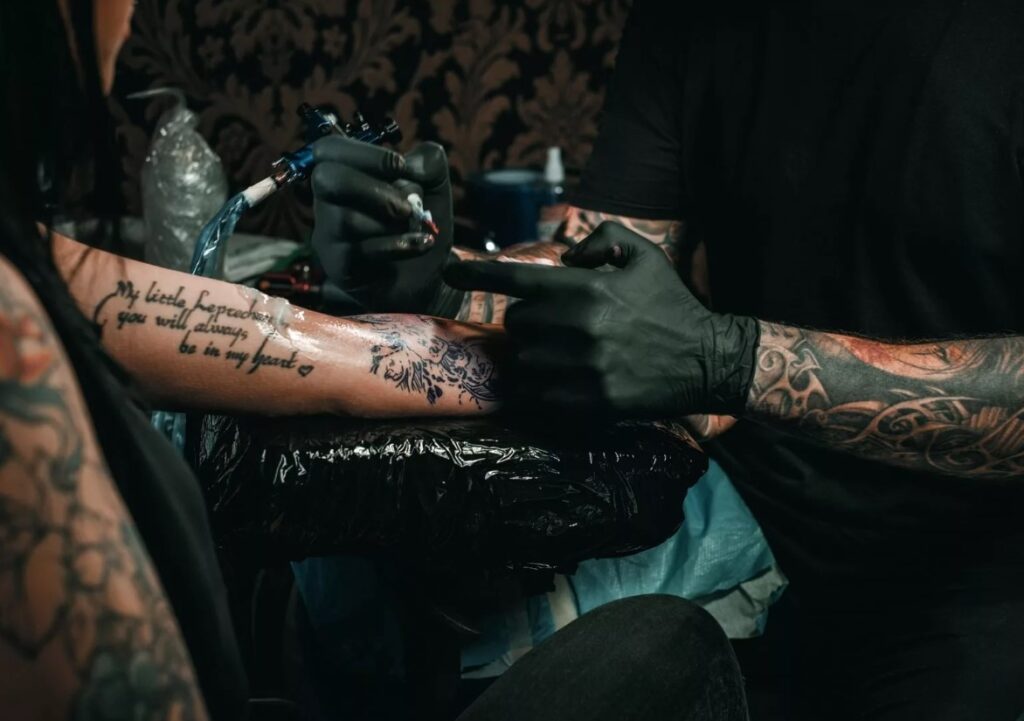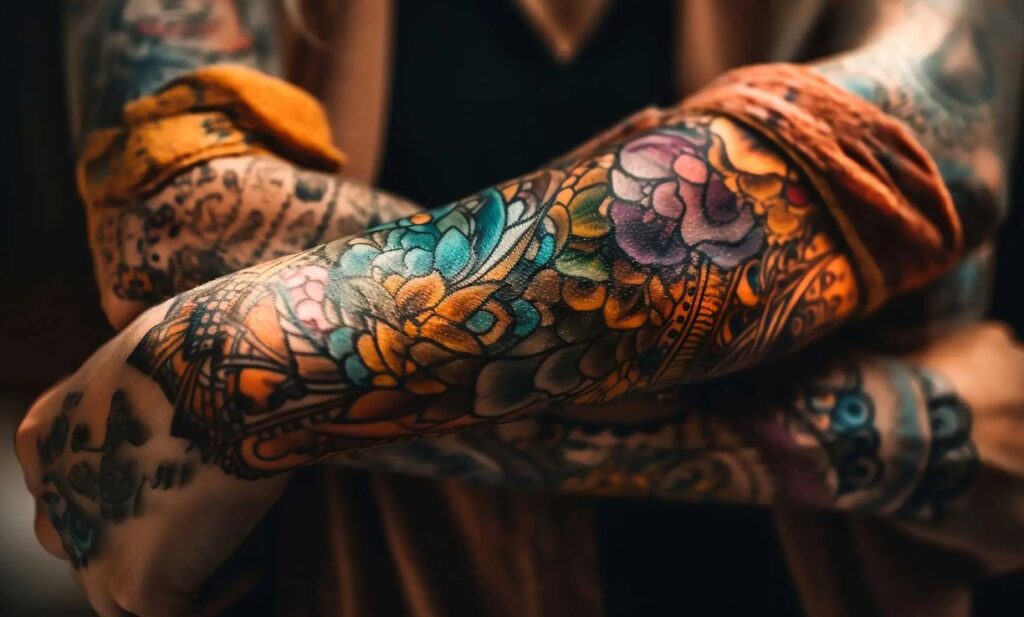Getting a tattoo is an exciting experience, marking a moment in time or a cherished symbol on your skin. However, the journey doesn’t end once the needle leaves your skin; proper tattoo care is essential to ensure both fast healing and vibrant, long-lasting colors. Understanding the importance of aftercare can make a significant difference in the outcome of your tattoo.
Immediately following the appointment, your skin will be sensitive and in need of extra attention. How you care for your new tattoo during the healing process can directly impact its appearance and longevity. By following a few key guidelines, you can minimize the risk of complications and ensure that your tattoo heals beautifully.
In this article, we will explore effective tips for tattoo aftercare that not only promote swift healing but also preserve the richness of the ink. From the initial cleaning process to long-term maintenance practices, we aim to provide you with comprehensive knowledge that will aid you in taking care of your body art. Remember, a well-cared-for tattoo will tell your story for years to come.
Understanding Your Tattoo’s Healing Process

The healing process of a tattoo generally occurs in three main stages: the initial healing, the peeling phase, and the final healing. Understanding these stages helps in providing proper care and ensuring a vibrant and long-lasting tattoo.
During the first stage, which usually lasts about 3 to 6 days, the tattooed area may appear red, swollen, and tender. This is the body’s natural inflammatory response to the trauma inflicted by the needles. It is crucial to keep the tattoo clean and moisturized during this time. Use a mild, fragrance-free soap to wash the area gently and an appropriate aftercare ointment or lotion to hydrate the skin.
The peeling phase follows the initial healing, typically occurring between days 7 and 14. As the skin begins to regenerate, you may notice the tattoo flaking or peeling. This is a normal part of the healing process; however, it is important not to pick or scratch at the peeling skin. Allow the tattoo to heal naturally to prevent scarring and color loss.
Finally, the skin usually completes its healing process within 2 to 4 weeks. While the outer layer may seem healed, deeper layers of skin continue to settle and integrate the ink. During this time, it’s essential to maintain a moisturizing routine and protect your tattoo from sun exposure, which can fade its colors over time.
Full healing can take up to several months, during which the tattoo will gradually soften and mature. Being mindful of your tattoo during this period ensures that it not only heals effectively but also retains its intended vibrancy for years to come.
Initial Aftercare: What to Do Right After Getting Inked
Following the completion of your tattoo, proper aftercare is crucial for healing and preserving the vibrancy of your ink. Begin by keeping the tattoo covered for the first few hours, as your tattoo artist will usually apply a protective bandage. This helps to shield the fresh ink from bacteria.
After the initial covering is removed, gently wash the tattoo with mild soap and lukewarm water. Use your hands, not a washcloth, to avoid irritation. Pat the area dry with a clean towel; do not rub, as this may disturb the healing process.
Once dry, apply a thin layer of a recommended ointment or tattoo aftercare cream. Avoid using petroleum jelly or other heavy products that can suffocate the skin. The goal is to keep the area moisturized but not overly greasy.
During the first week, it’s essential to refrain from soaking the tattoo in water, so avoid baths, pools, or hot tubs. Instead, take short showers and protect the tattoo by keeping it out of direct water flow.
In addition, do not pick or scratch the tattoo, even if it begins to itch. Your body will naturally form scabs, and picking at them can lead to color loss or infection. If itching persists, a gentle touch of fragrance-free lotion can help alleviate discomfort.
Avoid exposure to direct sunlight. UV rays can fade your tattoo quickly. If you need to go outdoors, cover the tattoo with clothing or apply a broad-spectrum sunscreen (once healed).
Other important habits include staying hydrated and maintaining a balanced diet to support your body’s healing. Remember to keep an eye on the tattoo for any signs of infection, such as excessive redness, swelling, or discharge. If any unusual symptoms arise, consult your tattoo artist or a healthcare professional.
By following these initial aftercare steps, you set the foundation for optimal healing and long-lasting tattoo quality.
Optimal Cleaning Techniques for Fresh Tattoos

Proper cleaning is essential for the healing of a fresh tattoo. It helps to prevent infection and ensures that the ink stays vibrant for years to come. Follow these guidelines for the best results.
1. Wash Your Hands: Always begin by washing your hands thoroughly with soap and water to eliminate any bacteria. This is crucial before touching your new tattoo.
2. Use Lukewarm Water: When cleaning your tattoo, use lukewarm water. Hot water can irritate the skin, while cold water may not effectively remove any impurities.
3. Gentle Cleanser: Choose a mild, fragrance-free antibacterial soap. Avoid products with harsh chemicals, alcohol, or fragrances, as they can irritate the skin and compromise healing.
4. Light Pressure: Gently apply the cleanser with your fingertips, using circular motions. Avoid scrubbing as it can disturb the healing skin and the ink.
5. Rinse Thoroughly: Make sure to rinse off all soap residue completely. Leftover soap can cause irritation and impede the healing process.
6. Pat Dry: Once cleaned, gently pat the tattoo dry with a clean, soft towel. Avoid rubbing, as this can damage the skin and the tattoo.
7. Moisturize: After cleaning, apply a thin layer of a recommended tattoo aftercare ointment or a fragrance-free moisturizer to keep the skin hydrated. This helps to promote healing and maintain color.
By adhering to these optimal cleaning techniques, you can ensure that your tattoo heals properly while preserving its vibrancy for the long term.
Choosing the Best Moisturizer for Tattoo Care
After getting a tattoo, proper moisturizing is essential to ensure optimal healing and color retention. Selecting the right moisturizer can greatly impact the longevity and vibrancy of your tattoo.
Key Ingredients to Look For
When choosing a moisturizer, focus on products that contain skin-friendly ingredients. Here are some beneficial components:
| Ingredient | Benefits |
|---|---|
| Aloe Vera | Soothes irritation, hydrates, and promotes healing. |
| Coconut Oil | Moisturizes deeply and possesses antibacterial properties. |
| Shea Butter | Rich in vitamins, it helps with nourishment and elasticity. |
| Vitamin E | Antioxidant that protects skin and supports healing. |
| Fragrance-Free | Reduces the risk of irritation and allergic reactions. |
Types of Moisturizers to Consider
Not all moisturizers are created equal. Here are some types you might consider for tattoo care:
- Lotions: Lightweight and easily absorbed, ideal for everyday use.
- Creams: Thicker consistency that provides deeper hydration, perfect for dry skin.
- Balm: Offers a protective barrier, useful for areas prone to friction.
Always test a small area of skin before full application to ensure there are no negative reactions. Properly moisturizing your tattoo will help it heal faster and maintain its stunning appearance for years to come.
Avoiding Common Mistakes in Tattoo Aftercare
Proper aftercare is essential for ensuring that your tattoo heals quickly and maintains its vibrant colors. Many individuals make common mistakes that can hinder the healing process or dull the tattoo’s appearance. Here are key mistakes to avoid.
1. Ignoring Aftercare Instructions
After receiving a tattoo, your artist will provide specific aftercare instructions. Ignoring these guidelines can lead to complications such as infections or faded colors. Always follow the advice given regarding cleaning, moisturizing, and protecting your new ink. If in doubt, consult with your tattoo artist again for clarifications.
2. Overwashing or Scrubbing the Tattoo
While it is important to keep your tattoo clean, overwashing or scrubbing the area can damage healing skin. Use lukewarm water and a mild, fragrance-free soap to gently cleanse the tattoo. Pat the area dry with a clean towel instead of rubbing, which can irritate the skin.
Another common mistake is using harsh soaps or exfoliants that can strip the skin of necessary oils. Choose products specifically designed for sensitive skin or tattoo aftercare to avoid irritation.
By avoiding these common mistakes, you can help ensure that your tattoo heals properly and retains its intended beauty for years to come.
Managing Itching and Peeling During Healing
During the healing process of a tattoo, it is common to experience itching and peeling as the skin repairs itself. Understanding how to manage these symptoms effectively can enhance comfort and prevent complications.
Itching often occurs due to the skin’s natural response to the trauma of the tattooing process. To soothe itching, avoid scratching the area, as this can lead to irritation or infection. Instead, gently pat the tattooed area to relieve discomfort. Keeping the tattoo moisturized with a recommended tattoo aftercare ointment can also help minimize itching. Apply a lightweight layer to let your skin breathe while still providing hydration.
Peeling is a normal part of the healing process and usually occurs around the second week after getting a tattoo. During this phase, the outer layer of skin may shed to reveal new skin underneath. It is essential to let the peeling happen naturally; do not pick or pull at the flakes, as doing so can remove color from the tattoo and increase the risk of scarring.
To manage peeling, continue to apply a gentle, fragrance-free moisturizer to the tattoo. This can help reduce the severity of the peeling and keep the skin hydrated. Additionally, wearing loose clothing over the tattoo can prevent friction, which may exacerbate both itching and peeling.
Always monitor the healing process for any signs of unusual irritation or infection, such as increased redness, swelling, or pus. If these symptoms arise, consult a professional tattoo artist or a healthcare provider for guidance. Following aftercare instructions carefully and understanding the natural healing progression can lead to a beautiful, long-lasting tattoo.
How to Protect Your Tattoo from Sun Exposure

Sun exposure can significantly impact both the healing process of a new tattoo and the longevity of its color. Protecting your ink from harmful UV rays is essential for maintaining its vibrancy and clarity. Here are effective strategies to safeguard your tattoo from sun damage.
1. Use Sunscreen
Applying sunscreen is one of the most effective methods to protect your tattoo from sun exposure.
- Choose a broad-spectrum sunscreen with an SPF of at least 30.
- Apply sunscreen generously on the tattooed area at least 15 minutes before sun exposure.
- Reapply every two hours, or more often if sweating or swimming.
2. Wear Protective Clothing
Physical barriers can provide additional protection for your tattoo.
- Consider wearing long sleeves or pants if you anticipate prolonged sun exposure.
- Look for clothing made from UV-protective fabric for added defense.
- Hats and scarves can also protect tattoos located on the upper body and neck.
By incorporating these protective measures into your routine, you can help ensure that your tattoo heals properly and retains its brilliance over time.
When to Consult a Professional for Tattoo Issues
Consulting a professional for tattoo issues is crucial to ensure your skin and tattoo remain in optimal condition. Seek immediate assistance if you notice any signs of infection, which may include excessive redness, swelling, pus, or an unusual odor around the tattooed area. These symptoms can indicate bacterial infection requiring medical intervention.
If you experience prolonged pain or discomfort that worsens over time, this may be a sign of complications. A professional can evaluate the situation and provide appropriate treatment to alleviate symptoms and prevent further issues.
Allergic reactions to tattoo ink or aftercare products can manifest as itching, rashes, or hives. If these reactions occur and do not subside with over-the-counter remedies, it’s essential to consult a medical professional or a dermatologist familiar with tattoo care.
Fading or blurry lines in a freshly healed tattoo can also prompt a visit to a specialist. Factors like improper aftercare or low-quality ink can affect the tattoo’s longevity. A tattoo artist may offer touch-up services or advice on how to maintain the tattoo’s vibrancy.
For individuals considering laser removal or correction procedures, it is vital to consult professionals experienced in these techniques. They can provide detailed information on the process, potential risks, and expected outcomes.
In summary, don’t hesitate to seek professional help if you observe any signs of infection, experience unusual reactions, or have concerns regarding your tattoo’s appearance. Early intervention can prevent complications and ensure your tattoo remains as intended.
Maintaining Tattoo Vibrancy with Proper Skincare
Proper skincare is essential for keeping your tattoo looking vibrant and fresh. The healing process significantly affects the longevity of the colors and the overall appearance of your tattoo. To ensure that your ink retains its brilliance, follow these skincare guidelines.
Hydration is Key
Keeping your skin hydrated plays a crucial role in maintaining your tattoo’s vibrancy. A well-moisturized skin barrier enhances color retention and prevents dryness that can lead to fading. Use a fragrance-free moisturizer or a tattoo-specific balm during the healing process and afterward. Apply it regularly, at least twice a day, to maintain suppleness and elasticity.
Sun Protection and Aftercare
Ultraviolet (UV) rays can significantly diminish the vibrancy of tattoo ink over time. To protect your tattoo, apply a broad-spectrum sunscreen with at least SPF 30 whenever you are outdoors. This should be done even on cloudy days. Additionally, avoiding prolonged sun exposure and tanning beds will help prevent colors from fading. During the healing period, keep the tattoo covered with loose clothing to minimize exposure until it has fully healed.
Timing for Touch-Ups and Ongoing Care
After getting a tattoo, proper care is essential to ensure both the longevity of the artwork and your skin’s health. Understanding when to schedule touch-ups and how to maintain your tattoo’s vibrancy is crucial.
Touch-Up Timing
- Plan for a touch-up approximately 4-6 weeks post-tattoo. This allows the skin to heal properly while ensuring that any missed spots or fading can be addressed.
- Consult your tattoo artist if you notice significant areas of fading or inconsistency in color before the recommended time frame. Each design and skin type may react differently.
- Keep in mind that certain factors, such as sun exposure and skin type, can affect the need for touch-ups.
Ongoing Care
- Moisturizing is key. Regularly apply a fragrance-free moisturizer or tattoo aftercare lotion to keep the skin hydrated.
- Use sunscreen to protect your tattoo from UV rays. This helps prevent fading and keeps colors vibrant.
- Avoid soaking in pools, hot tubs, or oceans for at least 2-3 weeks after getting a tattoo to prevent irritation and fading.
- Stay hydrated and maintain a balanced diet. Healthy skin can support the longevity of your tattoo.
Regular care and timely touch-ups will not only help your tattoo look its best but also promote overall skin health.
Debunking Myths About Tattoo Aftercare

Understanding the facts about tattoo aftercare is essential for maintaining your new ink’s vibrancy and ensuring proper healing. Unfortunately, many myths circulate that can lead to improper care and potential skin damage.
- Myth 1: You should wash your tattoo with alcohol or peroxide.Many people believe that using alcohol or hydrogen peroxide will disinfect the tattoo. However, these substances can be too harsh and may irritate the skin, slowing the healing process. It’s best to use mild soap and water for cleaning.
- Myth 2: The tattoo needs to dry out for optimal healing.Some think that letting a tattoo dry out will help it heal faster. In reality, keeping the tattoo moisturized with a recommended ointment aids healing by preventing scabbing and itchiness.
- Myth 3: You can’t exercise after getting a tattoo.While it’s best to avoid heavy sweating and strenuous activities in the initial days post-tattoo, moderate exercise can often be resumed after a short period. Just be cautious and listen to your body.
- Myth 4: You should cover your tattoo completely!Some people believe that keeping their tattoo fully covered all the time is necessary. While it’s important to protect your tattoo, it also needs exposure to air. A breathable covering, like a non-stick bandage, is sufficient.
- Myth 5: All lotions are good for tattoo care.Not all lotions are suitable for tattoo aftercare. Certain fragrances and chemicals can irritate the skin or fade the ink. Always opt for products specifically designed for tattoo aftercare or those that are fragrance-free and hypoallergenic.
Dispelling these myths ensures that you take proper care of your tattoo, promoting better healing and maintaining its beauty for years to come. Always consult with your tattoo artist for personalized aftercare advice based on your specific tattoo and skin type.
Q&A:
What are the most important steps to take immediately after getting a tattoo?
After getting a tattoo, it’s crucial to keep the area clean and moisturized to promote healing. First, gently clean the tattoo with mild soap and water, then pat it dry with a clean towel. Apply a thin layer of a recommended healing ointment or fragrance-free moisturizer. Avoid soaking the tattoo in water, like in baths or pools, for at least two weeks. Always follow your tattoo artist’s specific aftercare instructions, as they know what works best for their artwork.
How long does it typically take for a tattoo to heal completely?
The healing process for a tattoo generally takes about 2 to 3 weeks for the surface layer of the skin to heal. However, it can take up to 6 months for the deeper layers of skin to fully mend. During the first few days, the tattoo may scab and flake, which is a normal part of healing. To ensure proper healing, it’s important to follow aftercare guidelines consistently throughout this period.
What should I avoid doing to my tattoo to ensure it heals properly?
To promote proper healing of your tattoo, avoid picking at scabs or peeling skin, as this can cause scarring and affect the appearance of the tattoo. Don’t expose the tattoo to direct sunlight or tanning beds until it is fully healed, as UV rays can fade the ink and damage the skin. Also, steer clear of activities that could cause excessive sweating or friction on the tattooed area, such as intense workouts or tight clothing, especially in the first couple of weeks.
How can I maintain the color and appearance of my tattoo over time?
To maintain the vibrancy of your tattoo, keep the skin moisturized with unscented lotions regularly, as hydrated skin helps ink stay sharp. Always apply sunscreen with a high SPF when exposed to the sun; UV rays can cause fading. Staying hydrated and avoiding excessive sun exposure are key to preserving your tattoo’s color. If fading occurs, you might consider consulting a tattoo artist for touch-ups to keep your artwork looking fresh.
If you’re looking for a Trendy Tattoo Artist in Chicago, our studio is ready to provide unique designs and a professional approach to every tattoo.



